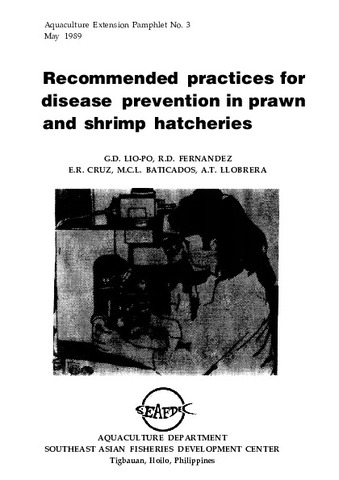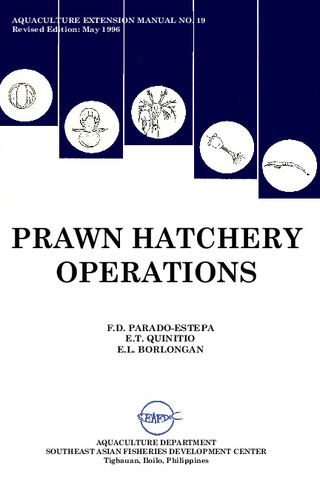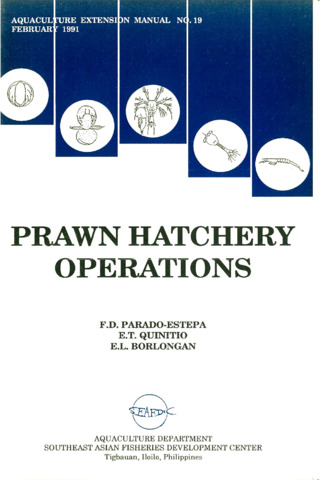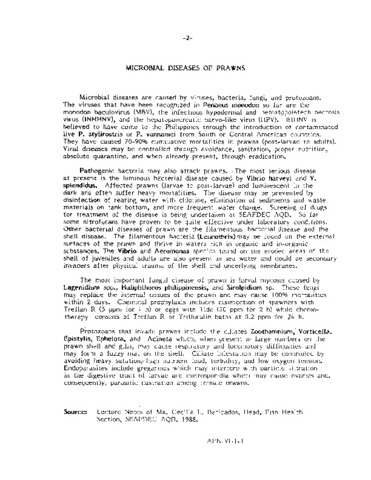Recommended practices for disease prevention in prawn and shrimp hatcheries
Share
trừu tượng
Disease in prawn is any abnormal condition which may affect adversely the appearance, growth, and function of the animal. It may or may not result in mortalities. Disease outbreaks occur commonly in different culture systems such as hatcheries and grow-out ponds.
Disease develops through the interaction of the prawn (the host), the causal agent (the pathogen), and the environment. In the presence of a susceptible host, a pathogen and predisposing environmental conditions (poor water quality, inadequate food, frequent handling, overstocking), disease is very likely to occur. Improved environmental conditions, healthy prawns and absence of disease agents would therefore lessen the chance of a disease outbreak.
The causal agents may be pathogenic organisms (viruses, bacteria, fungi, protozoa, helminths, microcrustaceans) or nonpathogenic adverse environmental conditions (extreme temperatures, low oxygen levels, chemical poisons). Living disease agents cause infectious disease which generally result in gradual mortalities. Non-living disease agents cause non-infectious diseases that result in sudden mass mortalities.
The environment determines the balance between the prawn as host and the disease agent. Microorganisms are always present in the water and some of them cause disease only when the prawn has been weakened through exposure to stressful environmental conditions.
Hatchery personnel should realize that they themselves could transmit disease through their contaminated hands, clothing, and footwear. Equipment such as water pumps, blowers, pipes, and materials such as scoop nets, water hoses, pails, glasswares are also possible carriers of disease agents. Spawners, live natural food like diatoms, rotifers and brine shrimp, and artificial diets could also be vehicles of disease transmission.
The prawn culturist, thus, must be able to manage the environment and make it favorable for the prawn. Hatchery management should, therefore, include operation procedures that will reduce the possibility of disease development during larval rearing. This manual recommends practices for disease prevention to prawn hatchery operators and technicians.
Suggested Citation
Lio-Po, G. D., Fernandez, R. D., Cruz, E. R., Baticados, M. C. L., & Llobrera, A. T. (1989). Recommended practices for disease prevention in prawn and shrimp hatcheries. Tigbauan, Iloilo, Philippines: Aquaculture Department, Southeast Asian Fisheries Development Center.
Chủ thể
Bộ sưu tập
Related items
Showing items related by title, author, creator and subject.
-
Prawn hatchery operations
Parado-Estepa, Fe D.; Quinitio, Emilia T.; Borlongan, Emeterio L. (Aquaculture Department, Southeast Asian Fisheries Development Center, 1996-05)The manual, an updated version of the 1984 SEAFDEC/AQD manual, presents the underlying principles and step-by-step instructions of prawn larval and post-larval rearing. The techniques described are not only applicable to ... -
Prawn hatchery operations
Parado-Estepa, Fe D.; Quinitio, Emilia T.; Borlongan, Emeterio L. (Aquaculture Department, Southeast Asian Fisheries Development Center, 1991-02)The manual, an updated version of the 1984 SEAFDEC/AQD manual, presents the underlying principles and step-by-step instructions of prawn larval and post-larval rearing. The techniques described are not only applicable to ... -
Microbial diseases of prawns
Southeast Asian Fisheries Development Center, Aquaculture Department (Aquaculture Department, Southeast Asian Fisheries Development Center, 1988)





